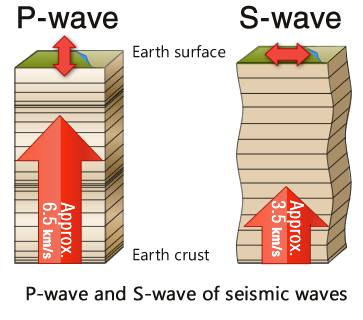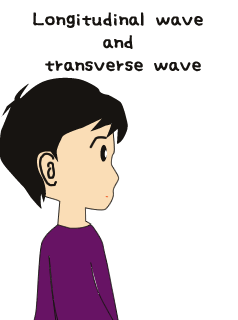- HOME
- Ono Sokki's Patio
- Seismic Wave

Seismic Wave
Ken: It's obvious, but the earthquake early warning is broadcasted before the earthquake, right? How do they predict it?
Dad: Have you heard of the P-wave and S-wave of the seismic wave?
Ken: P-wave and S-wave?
Dad: P and S stands for primary wave and secondary wave.
Ken: Do that mean there are different speed waves in the seismic waves?
Dad: Yes. With earthquake early warning, they predict the size and arrival time of the S-wave using the information of the P-wave that arrives first.
Ken: Does that mean S-wave is greater?
Dad: Yes. Look at this graph. At the earth's crust, the P-wave travels about 6.5 km/s and S-wave travels about 3.5 km/s.

Ken: There's almost twice the speed difference. Looking at this graph, the P-wave and S-wave have different shapes.
Dad: Yes. The reason for the speed difference is because although the waves progress in the same direction, the direction of wave vibration is different. P-wave is called the compression wave which repeats compression and rarefaction while traveling ...
Ken: That's the same as sound transferring in air.
Dad: Yes. Sound wave travels while compressing and rarefying the air. That is called longitudinal wave.
Ken: Then is the S-wave a transverse wave?
Dad: Yes. As you can see on the graph, it vibrates perpendicular to the direction of wave progression. Wave progression like this is called transverse wave.
Ken: But earthquakes have vertical vibration. Are these P-waves?
Dad: Yes. When the epicenter is right under, it becomes vertical vibration of P-waves. Vibration that the P-wave causes is called preliminary tremor, and is not usually big. The later S-wave is the principal shock, which is the big vibration. Especially when it enters a soft ground from hard ground, the amplification becomes bigger.
Ken: Why is that?
Dad: For example, a soft tofu is on top of a hard board. If you shake the hard board, the tofu shakes vigorously, right?
Ken: I see. The S-wave becomes bigger due to the structure of stratum.
Dad: There's one more wave called the surface wave. When the seismic wave reaches the earth's surface and travels along the surface, if the frequency becomes long, some to 10 and more seconds, its vibration may become larger than that of the S-wave.
Ken: Is that related to the nature of the ground?
Dad: Yes. Tokyo has a thick sedimentary layer, so the surface wave tends to become amplified. If the frequency of the surface wave matches with the natural frequency of a high-rise, it could become a greater shake.
Ken: It would be better if earthquake early warning could predict the time and size of the earthquake in the future, not just immediately before.
Dad: I hope so too. I heard that the research of earthquake prediction has advanced fairly, but it hasn't reached to the level to make such forecasting. If it becomes possible, damage from earthquake can be minimized.
- © ONO SOKKI CO., LTD. 1996-2025
